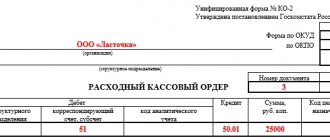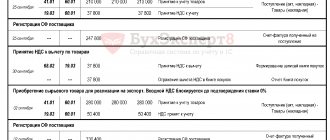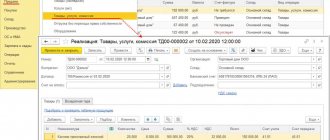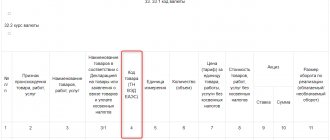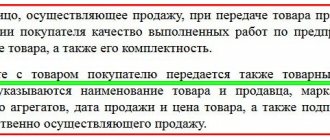Let's continue to understand the intricacies, ambiguities and subtleties of invoices: how and when to make corrections to an invoice, how a corrected invoice differs from an adjustment invoice, is it possible to accept an adjustment instead of a corrected one...
There are a lot of questions: what to take. when to reflect how tax liabilities are affected. The topic is hot. Current. Discussed and often commented on by controllers - the Ministry of Finance and the Federal Tax Service.
Shall we discuss?
So, if the supplier made critical errors in the invoice, he must correct them. In case they may be an obstacle to the buyer receiving a tax deduction. About significant and minor errors in the article “Damage invoice. Or suitable?
If critical errors are detected in the invoice, you must contact the seller to make corrections to the invoice. And your business partner must correct them.
How to correct errors on an invoice
Corrected is a new invoice with the correct data filled in line 1a. In essence, this is a clarified document.
Important: 1. Line 1 indicates the number and date of the invoice with errors.
2. Line 1a indicates the serial number and date of correction of the original (erroneous) invoice (“correction No. 1 dated “__”_____2019).
The remaining lines and fields are filled in as in the original invoice, but with the correct values.
The corrected invoice is drawn up in two copies: for both the buyer and the seller.
If a defective invoice was recorded in the purchase book (from the buyer) and in the sales book (from the seller), it should be canceled and a corrected one should be registered.
Functionality provided by the invoice
An invoice (hereinafter we use the accepted abbreviation сч-ф) is the most important document that is used to account for value added tax.
In general, the seller and buyer apply the common taxation system (CTS). That is, they are VAT payers.
There are several types of invoices:
Our material is devoted to the corrected invoice. Below we will look at the cases in which a correction invoice is used in document flow, and how it differs from a correction invoice.
Reflection of corrections in accounting and reporting
1. If the correction occurs in one quarter:
The seller cancels the entry for the erroneous invoice in the current period's sales ledger and records the corrected invoice. Cancellation will be carried out by re-registering the document in the sales book with negative indicators.
The buyer makes similar entries in his purchase book.
2. If an invoice drawn up in the previous period is corrected , then the seller and buyer make the same entries, but only in additional sheets to the sales book (purchase book) of the period in which the erroneous (initial) invoice was registered. And also two entries are made in the additional lists: the previous invoice is canceled and the corrected one is registered.
If, as a result of corrections, the final data of the sales book (purchase book) has changed, you must submit an updated declaration. And if the amount of VAT payable for the corrected period increases, you need to pay additional tax and penalties.
Features of filling out and registering the corrected ESF
It is impossible to issue a revocation of an erroneous invoice if the document is listed in the registration journals. Therefore, you will have to not only submit new documents, but also add cancellation of the incorrect ESF. Accounting departments should also take into account that there are clear criteria for registering an amended invoice. This is important to consider for the possibility of obtaining VAT.
A typical situation is when the ESF with amendments is received in the same quarter as the original document. In this case, the service or product provider records the corrected and erroneous invoice. The primary document is entered with a minus sign.
For example, on 02/02/2020, enterprise “K” sold a batch of goods. A week later, it was discovered that the recipient's TIN was incorrect on the invoice. Accordingly, Enterprise “K” issued a corrected ESF and registered it on 02/19/2020. The primary document is also registered on the same date, but in a negative value. Accordingly, the balance in the sales book for the erroneous document is reduced to zero, and only the new, corrected ESF remains. For the buyer or recipient of services, the procedure is similar, but if an error is detected before the incorrect invoice is registered, only information about the correct ESF is entered into the purchase ledger.
Let's look at another example. The buyer received an invoice in the first quarter of 2022, but discovered the error only in the second. In this case, information about the documents is recorded in an additional sheet of the purchase book.
As in the previous case, the corrected and original document is registered with a minus sign. It is extremely important to cancel the balance, since in the future this will have a direct impact on the calculation of VAT.
Although the law allows you to send an invoice with typos to your counterparty, in practice it is better to double-check the document in advance. The implications are purely technical and add unnecessary work. In addition, if the error is discovered late, problems may arise with the tax authorities. For example, if the cost of a product was underestimated relative to the market value, this fact may be considered as an attempt to illegally reduce the amount of taxation. This involves administrative and, in some cases, criminal liability.
We will quickly implement EDI for the exchange of electronic invoices
Symmetry is also important for minor errors.
It is possible that a cautious buyer will insist that the seller make a correction to the document even in the event of a minor error in the invoice.
Important: even if these are technical errors (number, date of the document, etc.), the seller must register the corrected document in the sales book. So that the corrected invoice information from the sales ledger is included in the tax return.
Otherwise, the ASK VAT-2 verification program will reveal a gap and the buyer will be denied a deduction.
Please note: the Ministry of Finance in letter dated May 6, 2022 N 03-07-11/32905 admitted that if the seller corrects a minor error (shortcoming), he may not register the invoice in the sales book. But in order to apply the deduction to the buyer, the mirror image of current invoices must be observed.
To be on the safe side, it is useful to request from the seller certified copies of the relevant sheets from his sales book.
Such an unconventional UPD
If your counterparty uses a UTD (universal transfer document), be sure to make sure that the document received from him in the part in which it replaces an invoice:
- fully complies with the invoice format approved by current legislation,
- it contains all the necessary details,
- and they are indicated correctly.
The UPD form was approved 6 years ago by letter of the Federal Tax Service dated October 21, 2013 N ММВ-20-3/ [email protected] Since then, a lot of significant changes have been made to the rules for filling out invoices, approved by Resolution No. 1137. The UPD form is lagging behind. And no one is in a hurry to update it.
The Ministry of Finance and the Federal Tax Service in their letters advise independently supplementing the UPD, which combines the form of an invoice and a primary accounting document, with the indicators necessary to fulfill the requirements established by Article 169 of the Tax Code and the Rules for filling out an invoice used in calculations of value added tax , approved by Decree of the Government of the Russian Federation N 1137. (letters of the Ministry of Finance and the Federal Tax Service dated April 22, 2022 No. ED-4-15/7638, dated September 14, 2022 No. ED-4-15/18322.
Advice: if you use UTD, it is worth reworking its form, bringing it into line with the current invoice form. And fix the form of this primary document in the annex to the accounting policy.
If the seller has issued you an UTD, carefully check the document to ensure it corresponds to the current invoice form. And each of its details.
Otherwise, the tax office will cancel the VAT deduction based on the UTD using an outdated form with incomplete indication of details.
Correcting an error in an invoice should not be confused with the procedure for issuing a correction invoice.
For VAT purposes, correction of an error and adjustment are two completely different concepts. And it is necessary to clearly understand when it is necessary to correct a previously issued invoice, and when to prepare an adjustment for it.
Components of an adjustment act
An adjustment report differs from a work completion certificate in its name and in the method of filling it out. The remaining elements of the document remain unchanged.
Since people work with documentation, typos and erroneous data in papers are a common occurrence. If for some reason incorrect details or price or quantity of goods were indicated, then an adjustment report cannot be avoided. Naturally, if the invoice and all related papers do not contain errors, there is no need to make adjustment papers on them.
The main nuances that must be indicated in the act for normal work with the counterparty include:
- Name and number of the act. The latter is necessary for recording in the journal of incoming documentation of business partners.
- Artist's name.
- INN, checkpoint, address of the organization.
- Serial number.
- Name of the product or service provided.
- A unit of measurement for a product or service. A separate row in the table is allocated for each name.
- Quantity.
- Unit price.
- The total cost of services provided or goods sold.
- A note indicating that there are no claims regarding quality and delivery time from the customer. Standard wording, unchanged for all such documentation. The customer, by signing the adjustment report for the work performed, agrees that the data indicated in the paper coincides with the real state of affairs, and the recipient is also convinced that he has no complaints regarding the quality, quantity of the product or service and the time of receipt.
At the very end of the act, representatives of the customer and the contractor sign. For a document to have legal force, it is not enough just to sign. It is necessary to decipher the signature with the surname and initials of the person who has the right to sign such documents.
Correction and error correction are two very different things
Completely different operations with completely different grounds, their own rules of documentation and reflection in accounting and reporting.
So, the adjustment conditions:
1.Adjustment - only if the cost changes.
An adjustment invoice is issued only when the cost of goods already shipped, work performed, services rendered, or transferred property rights is changed.
A change in price may be caused by:
- shortage of goods was detected,
- after shipment, the seller provided the buyer with a retro discount,
- sale of goods at a preliminary price with subsequent recalculation,
- changing the price in court at the request of one of the parties.
2. The adjustment must be formalized as a primary document. By which the parties agreed to reduce or increase the price of the product, or specified its quantity.
This may be a change (addition) to the contract, agreement, or other document confirming the fact of notification of a change in the terms of the transaction and confirming the buyer’s consent.
Important: The date of these documents must be later than the date of shipment. They confirm the fact that the change occurred after shipment.
Primary documents may be, for example, 1) an act on establishing a discrepancy in quantity and quality when accepting goods and materials in form No. TORG-2, 2) an act on price changes signed by the parties, 3) a court decision that has entered into legal force, and others
If there is no primary basis document, there is no need to issue an adjustment invoice. This is what the Ministry of Finance thinks in its letter dated February 9, 2022 No. 03-03-06/1/7833.
If, when issuing an invoice, inconsistencies or errors were initially made, including arithmetic, in value, in amount, such documents are not issued. Issuing an adjustment invoice in this case will be unlawful. To correct the error, a corrected invoice is issued.
Reflecting adjustments - according to your own rules
So, documents on changes in the value of previously shipped goods have been drawn up, the buyer’s consent to the change in value has been received, and an adjustment invoice has been issued.
The task is to correctly reflect the adjustment in accounting.
And the basic rules are:
- The accounting reflects the difference .
- The tax base of the current period . Regardless of the period in which the goods were shipped. The tax base calculated at the time of shipment is not subject to adjustment.
If the cost of shipped goods has increased, then in the current period (adjustment period):
- the seller includes the resulting difference in the tax base of the current period, regardless of the period in which the goods themselves were shipped;
- the buyer declares for deduction the difference between the VAT amounts calculated before and after the adjustment.
If the cost of shipped goods has decreased, then in the current period (adjustment period):
- the seller declares for deduction the difference between the VAT amounts calculated before and after the adjustment;
- the buyer recovers the VAT amount in the amount of the difference between the VAT amounts before and after the adjustment.
Some people remember that before 2013, adjustment invoices had to be registered in additional lists. Moreover, for the period when the shipment took place. This necessitated the submission of updated tax returns to the tax authority for the period of shipment of goods. Pay the difference in VAT and penalties.
As of July 1, 2013, this is no longer required. Now the differences that arise are reflected in the tax base of the current period . Therefore, the declarations do not need to be clarified, and no penalties will be charged.
Features of accounting in one period and in different ones
If the cost of shipped products (services, property rights) increases in the current period (adjustment period):
- in the current period, the seller includes the resulting difference in the tax base, regardless of the period in which the products (services, property rights) were shipped (clause 10 of Article 154 of the Tax Code of the Russian Federation);
- the buyer makes a tax deduction for the difference between the VAT calculated before and after the adjustment (clause 13 of Article 171 of the Tax Code of the Russian Federation).
Kontur.VAT+ takes into account adjustments and corrections and verifies the results with counterparties for all quarters.
Find out more
If the cost of shipped products (services, property rights) decreases in the current period (adjustment period):
- the seller makes a tax deduction for the difference between the VAT calculated before and after the adjustment (clause 13 of Article 171 of the Tax Code of the Russian Federation). At the same time, the tax base, which was determined at the time of shipment of products (services, property rights), is not adjusted;
- the buyer recovers VAT for the amount of the difference between the VAT calculated before and after the adjustment (clause 4, clause 3, article 170 of the Tax Code of the Russian Federation);
- adjustments for reduction are carried out with KVO 18.
The seller and buyer reflect these transactions in their purchase and sales books as follows:
To correctly record adjustments in the books of purchases and sales in different reporting periods, use the following cheat sheet:
Example 1
According to the lease agreement between Sokol (lessor) and Lastochka (tenant), the rent amount is 106,000 rubles.
per month (including VAT). According to the additional agreement concluded in February 2022, the rental payment increased to RUB 112,600. per month (including VAT). According to the additional agreement, this change is effective from October 1, 2022. For the 4th quarter of 2022, rent amounted to RUB 318,000. (including VAT - 48,508 rubles). After concluding an additional agreement in February 2022, rent for the 4th quarter of 2022 increased to RUB 337,800. (including VAT - RUB 51,529).
In February 2022, after signing the additional agreement, Sokol issues an adjustment invoice to Lastochka and indicates:
- the previous amount of the lease payment for the 4th quarter of 2022 (RUB 318,000, including VAT - RUB 48,508);
- new rental payment amount for the 4th quarter of 2022 (RUB 337,800, including VAT - RUB 51,529);
- difference (increase) (RUB 19,800, including VAT - RUB 3,020).
In this situation, Sokol increases the tax base for the 1st quarter of 2019 by registering an adjustment invoice in the sales book for this period by 16,780 rubles. (without VAT).
Lastochka has the right to deduct VAT in the amount of RUB 3,020 in the 1st quarter of 2022. according to the adjustment invoice received from Sokol, registering this invoice in the purchase book of the 1st quarter of 2022.
Example 2
In September 2022, Sokol shipped products worth RUB 96,000 to Lastochka.
(including VAT - RUB 14,644). In February 2022, the parties agreed to reduce the cost of shipped products. The cost after reduction was 82,400 rubles. (including VAT - 12,569 rubles).
In February 2022, Sokol issues an adjustment invoice to Lastochka, indicating:
- the previous cost (96,000 rubles, including VAT - 14,644 rubles);
- new cost (RUB 82,400, including VAT - RUB 12,569);
- difference (decrease) (RUB 13,600, including VAT - RUB 2,075).
In this situation, in February 2022, Sokol has the right to claim VAT in the amount of 2,075 rubles. according to the adjustment invoice issued to Lastochka. To do this, Sokol registers the adjustment invoice issued to Lastochka in its purchase book for the 1st quarter of 2022.
Lastochka in February 2022 must restore VAT in the amount of 2,075 rubles indicated in the adjustment invoice received from Sokol. In this regard, in February 2022, Lastochka must make a restoration entry in its sales book for the 1st quarter of 2019.
Registration of corrections depending on the period occurs according to the scheme presented below.
The practice of drawing up adjustment invoices has shown that adjustments to the cost of goods, services or property rights can be carried out repeatedly.
Please note: When a re-adjustment occurs, the seller will issue an adjustment invoice. It records the data from the previous adjustment invoice. This is how the next adjustment invoice includes the difference between the new data and the data from the previous adjustment.
In this case, the new adjustment invoice includes the date and number of the previous one. It is registered by the parties in the books of sales and purchases in the generally established manner for the amount of the difference indicated in it. In this case, the records of the previous adjustment invoice are not canceled (they remain in the form in which they were reflected when it was issued).
The details have changed, what about the adjustment?
If, from the moment of initial shipment to the moment of adjustment, the basic details of the seller or buyer, for example, address, have changed. In this case, the adjustment invoice indicates new details - those that are valid at the time the adjustment invoice is issued.
Advice: when signing their agreement to change the price, it is advisable for the buyer and seller to clarify their details. If the obligation to notify about this is not fixed by the terms of the contract.
What is a corrected ESF and how does it differ from an adjustment?
Let's start with the fact that the Decree of the Government of the Russian Federation dated December 26, 2011 No. 1137 provides for two forms of invoices: main and adjustment. Both contain a box for making amendments.
It follows from this that the revised ESF is an original document, which, due to objective reasons, needed to be changed. Eligible criteria for making changes include:
- Technical errors;
- Incorrect amounts indicated;
- Typos.
It is important to note that only those points that actually distort the meaning of the document and lead to a change in the tax deduction are subject to correction. This is enshrined in paragraph 2 of Art. 169 Tax Code of the Russian Federation
The algorithm for working with corrected and corrective invoices does not differ for documents on paper and for electronic versions. That is, if the original document was created in electronic form, then all corrected and corrective SFs must also be in electronic form.
Corrective EFS is directly provided for by law and is necessary in situations where the objective conditions of the transaction have changed. For example, the seller and buyer signed an additional agreement to change the price. This decision assumes that the value of VAT is also subject to recalculation. Accordingly, a correction invoice is required.
It is important to note that the formation of a corrective ESF and the introduction of corrections to it or the original document is not considered a violation and does not entail liability. Naturally, if the edits were made before submitting the primary report to the Federal Tax Service.
For clarity, look at the infographic:
Fig. 1 Difference between the corrective SF and the corrected one
About a single (consolidated) adjustment
The Tax Code provides for the possibility of generating unified (consolidated) adjustment invoices - invoices. Naturally, they were issued to the same buyer.
The seller can collect invoices that are subject to adjustment and enter data on them into a single adjustment invoice. At the same time, there will be only one adjustment invoice, and there will be only one entry for it in the books of the seller and the buyer.
Issuing a single adjustment invoice is not an obligation, but the right of choice of the seller . For some this is convenient. To reduce the number of documents and simplify accounting.
You can combine both options for issuing adjustment invoices - separate or single. There is no need to fix the choice option in the accounting policy.
A single adjustment invoice may indicate that the cost has increased for some items and decreased for others. In this case, it is necessary to separately summarize the data and reflect them separately in the final lines “Total increase (sum of lines B)” and “Total decrease (sum of lines D)”. The seller and buyer register such an adjustment invoice twice : in the purchase books and sales books, respectively.
Types of acts
There are several ways to correct the initial data:
- Indicate the full cost of the correction. That is, the paper contains two numbers: new and old.
- Indicate the difference in indicators. That is, the act contains the old amount, the amount of the adjustment and states in which direction the adjustment is made.
- Indicate the new amount, the adjustment amount, and also the direction in which the original figure has changed.
The first and second options are the most practical, but the organization has the right to use any form of an adjustment report for work performed. The main thing is that it is reflected in the accounting policies.
Adjustment after adjustment
Adjustments to the cost of goods can be made repeatedly . In this case, for each subsequent adjustment, the seller issues an adjustment invoice to the buyer, which includes the data from the previous adjustment invoice. And it reflects the difference (increase or decrease) between them.
The number and date of the previous adjustment invoice are entered in line 1b of the subsequent (new) adjustment invoice.
A new adjustment invoice is also recorded in the current period for the amount of the difference. Entries on the previous adjustment invoice are not canceled and remain as they are in that period.
Results
Changes to the invoice and adjustment invoice not related to amendments to the quantity, cost of goods (work, services) and tax obligations are made accordingly on the form of the invoice, adjustment invoice.
When drawing up correction documents, it is necessary to indicate the details of the original document in which the error was made. The procedure for registering a corrective invoice depends on the period in which it was drawn up in relation to the erroneous invoice, and for the buyer also on whether he or she registered an invoice containing errors in the purchase book. You can find more complete information on the topic in ConsultantPlus. Free trial access to the system for 2 days.
Return of goods
From April 1, 2022, the return of goods - both full and partial - is issued only with adjustment invoices.
Why: by government decree No. 15 of January 19, 2022, amendments were made to paragraph 3 of the Rules for maintaining the sales book, eliminating the obligation for the buyer to issue invoices for goods accepted for registration in the event of their return to the seller.
For the return of goods, the seller (!) must issue an adjustment invoice. It is he who will accept VAT for deduction on adjustment invoices.
The Ministry of Finance, in a letter dated April 10, 2022 No. 03-07-09/25208, warned: if, when returning goods accepted for registration, the buyer issues an invoice in the old manner, the seller will lose the right to deduct. Therefore, be careful!
Regarding returns, there is another letter from the Ministry of Finance dated April 8, 2022 No. 03-07-09/24636: if the return is formalized by an independently concluded purchase and sale (or supply) agreement, then VAT can be deducted on the invoice of the returning buyer product. In this case, in the contract the original buyer must be the seller, and the original seller must be the buyer.
What happens if you issue an adjustment invoice instead of a corrected one?
Since the rules for registering adjusting and corrected invoices in the purchase books and sales books, as well as the procedure for applying tax deductions on them, are significantly different, both the buyer and the seller bear the risks.
Let's figure it out.
Yes, it’s possible that adjustments are convenient: you don’t need to plow through past periods, fill out additional sheets and prepare clarifications. In what period the document was received - in the same period it was reflected in the accounting.
But according to the rules established by law, an adjustment invoice can be issued subject to three conditions : 1) after shipment, the cost of the transaction changes 2) the parties have agreed on this 3) the primary document is available - the basis for the adjustment.
If one of the conditions is not met, the previously issued invoice must be corrected. Issuing an adjustment invoice will be illegal. And recognizing deductions on its basis is risky . The Ministry of Finance warned about this in a letter dated December 18, 2022 No. 03-07-11/84472. The same explanations are contained in numerous other letters from the controllers of the Ministry of Finance and the Federal Tax Service.
Seller's risks.
1. If, as a result of correcting the error, the cost of shipment has decreased - in the case of an incorrectly issued adjustment invoice - the seller faces refusal of a tax deduction for the amount of the difference between VAT, additional tax assessment, and penalties for tax liability for incomplete payment of tax.
2. If, as a result of correcting the error, the cost of shipment is increased - in the case of an incorrectly issued adjustment invoice - the seller faces additional tax, penalties and a fine due to underpayment of VAT for the shipment period.
3. For violation of the accounting procedure and the absence of corrected invoices, the seller may be brought to tax liability under Article 120 of the Tax Code and to administrative liability under Article 15.11 of the Code of Administrative Offenses for gross violation of the rules of accounting and taxation objects.
Buyer's risks.
If, as a result of correcting the error, the cost of shipment is increased , the buyer - based on an incorrectly issued adjustment invoice received from the seller - loses the right to deduct the positive difference between the VAT amounts in the period of making the adjustment.
Therefore, require the seller to correct errors by issuing corrected invoices rather than corrective ones. In compliance with the correct order of their reflection in accounting registers and tax reporting.
Adjustment invoice or correction?
Federal Law No. 245-FZ of July 19, 2011, which amends the first and second parts of the Tax Code of the Russian Federation, secured the right of companies to issue adjustment invoices. Government Decree No. 1137 dated December 26, 2011, among other things, approved the recommended form of this document.
- Sample of filling out an adjustment invoice in Diadoc
- Adjustment and corrected invoices in electronic form
When clarifying an invoice, first of all, you should distinguish between the cases when an adjustment invoice (ACF) is drawn up, and when corrections are made to an existing invoice. It is important to understand that the CSF has a separate form, and the corrected invoice (IF) is, in fact, the same invoice to which a correction was made and this correction was recorded in a new document with a serial number.
Adjustment invoice
An adjustment invoice is issued when the cost of goods sold, work performed, services rendered changes (in other words, when the tax base changes). A decrease or increase in cost (column 5 of the invoice) can be caused, inter alia, by a change in price (column 4), clarification of the quantity or volume of goods, works or services (column 3).
Another important condition for drawing up the CSF, according to paragraph 10 of Art. 172 of the Tax Code of the Russian Federation, there is a certain agreement of the parties that the cost will be changed. This consent can be formalized in the form of an additional agreement (as a bilateral document), in the form of a notification (unilateral document) and a primary document (for example, a Statement of Discrepancy). In each specific case, you can do what is more convenient for the seller and the buyer.
The rights and obligations to the budget recorded in the adjustment invoice relate to the period in which it was issued. Thus, on the basis of the CSF, compiled in the direction of reducing the amount of goods (work or services) shipped, the seller has the right to receive a VAT deduction. That is, now, if the seller did not deliver part of the goods, he generates a negative invoice, the amount of the goods and, accordingly, the tax is reduced, which means he has the right to deduct the difference between the original VAT and the VAT on the adjustment invoice (clause 1 and clause 2 Article 169 of the Tax Code of the Russian Federation). But the buyer in this case must restore the difference between the VAT amount of the original invoice submitted for deduction and the VAT amount of the adjustment invoice. Such an obligation arises for him in the tax period when he received the CSF or corrected primary documents (clause 3, article 170 of the Tax Code of the Russian Federation). If the amount of goods (work or services) has increased, the VAT has also increased, which means the buyer has the right, on the basis of the CSF, to receive “additional” deductions (clause 13, article 171 of the Tax Code of the Russian Federation).
Corrected invoice
Corrections in the invoice are made if an error is found in the document (for example, a typo, incorrect tax rate, error in details), as well as when bonuses are awarded without changing the price of the goods sold and when the goods are returned. During the correction process, a new copy of the invoice is created - an amended invoice (IF). Regardless of the date of correction, rights and obligations to the budget relate to the period when the original invoice was issued.
Error correction
Please note that not every error in the invoice requires a new, corrected copy. According to Resolution No. 1137, if an error does not lead to a refusal to refund VAT (for example, it does not prevent the tax authorities from identifying a buyer or seller, determining the name of a product (work, service), cost, tax rate or tax amount), then the accountant does not need to draw up a corrected invoice.
If the accountant finds an error in the adjustment invoice, then it would be appropriate to check the original invoice for the presence of a similar error: if there is an error in both documents, then it will have to be corrected by drawing up two corrected invoices - separately to the original and adjustment invoices.
Separately, it should be said about corrections to invoices issued before the entry into force of Resolution No. 1137: according to this resolution, corrections to invoices drawn up in the old form in paper or electronic form are made in the old way, by crossing out the incorrect indicator.
Numbering of invoices
The numbering of CSF and invoices within one period is continuous, and the numbering of corrections within one invoice always starts from 1, and the number of corrections is not limited. For example, we created a “shipping” invoice under No. 20, then we discovered some error in it and created a new version of invoice No. 20, correction No. 1. Then we noticed another missed error. Let's create another version of invoice No. 20, correction No. 2. Let's say that after this we draw up the next numbered invoice No. 21 for another transaction. After this, it turns out that an adjustment invoice must be issued for the previous shipment. Then we will have to draw up an adjustment invoice No. 22 to invoice No. 20, taking into account correction No. 2. If after this we again need to issue a correction invoice for invoice number 22, then we will have to issue it under number 23. Corrections for adjustment invoices are prepared in the same way as for the original invoices.
It is important to note that Resolution No. 1137 was the first to allow fractional numbering for invoices: such numbering can be used by organizations that have separate divisions, partnership participants or trustees.
Unreliable supplier
The carelessness or inattention of the supplier can seriously let the buyer down and leave him without a deduction.
More than once, businesses have tried to challenge in court the constitutionality of the provisions of the Tax Code, which make the taxpayer’s right to receive tax deductions dependent on compliance with tax legislation by its counterparties. But, unfortunately, the judges of the Constitutional Court of the Russian Federation did not find anything unconstitutional in these norms.
Russian judicial practice confirms that business liability is limitless. Checking potential counterparties is already a duty. With severe penalties for non-compliance: 1) accusation of complicity and 2) refusal to reduce the tax base and recognize deductions.
Of course, you can argue. But given the budgetary position of the courts, this is not always productive.
Therefore, it is important to calculate the risks and take timely measures to ensure the safety of your business. Be in the trend of current events. Know the tricks and understand the right moves.
In a fresh letter dated May 6, 2022 No. 03-07-11/32905, the Ministry of Finance once again warned that a corrected invoice that is not registered by the seller in the sales book deprives the buyer of the right to deduct VAT.
Making your legal right to a deduction dependent on the integrity or mood of the supplier is imprudent and risky. It's worth insuring yourself. It is useful to include in an agreement with a supplier - both a trusted partner and one chosen for the first time - a mandatory condition on the exchange of documents - the presentation by the seller of certified copies:
— additional sheets of the sales book (in case of correction of invoices) and
— current sheets of the sales book (in case of issuing adjustment invoices).
And further. It is advisable to include in contracts with suppliers other additional measures of responsibility that invigorate the counterparty. Eg:
- introduce a condition on a penalty for failure to submit properly executed documents within the established time frame: invoices, certified copies of sales book sheets and others;
- include in the contract a condition on assurances about the circumstances (in accordance with Article 431.2 of the Civil Code);
- stipulate in the contract the responsibility of the counterparty to compensate for property losses resulting from its violation of the law or obligations and guarantees under the contract. In this case, the contract must indicate the basis for compensation for losses;
and other useful conditions given in the article “Agreement with the counterparty. We manage risks."
If the counterparty is decent, he will not persist in accepting additional terms to the agreement. For him, these conditions do not entail any complications or problems.
If the counterparty avoids submitting documents or refuses to sign the proposed version of the contract, this is a reason to think about the reasons for his opposition and evaluate the advisability of choosing this particular counterparty to execute the contract.
If an unscrupulous seller delays in submitting documents, additional liability measures will help recover damages from him in a civil dispute. Without waiting for a tax audit and its results.
